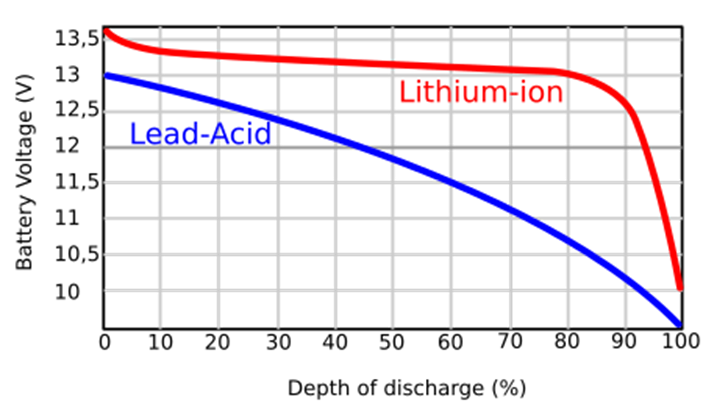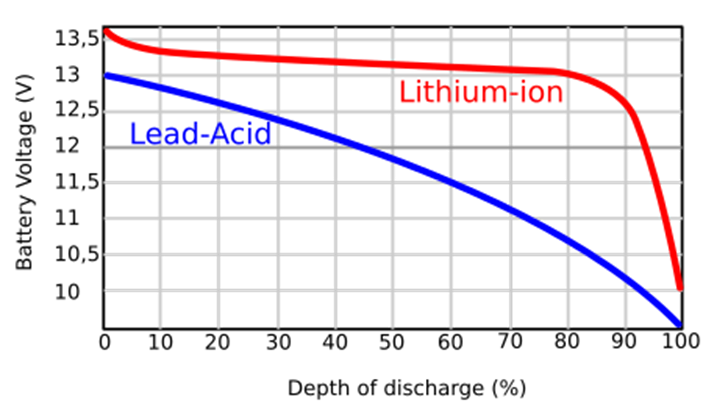How is a Lithium-Ion battery different than a Lead-Acid battery?
This is the second in a six-part series on lithium batteries:
- What’s Inside a Lithium-Ion battery? link
- How is a Lithium-Ion battery different than a Lead-Acid battery?
- Which is a better Lithium-Ion battery, NMC or LFP?
- Aren’t all Battery Management Systems (BMS) the same?
- What is the future of lithium batteries?
- Beyond Lithium Ion - what’s the future of energy storage and renewable energy generation?
First, although AGM (Absorbed Glass Mat) and flooded batteries are both considered lead-acid batteries, they are different. An AGM battery has a thin glass-mat separator that absorbs the electrolyte. Flooded batteries need to be topped off with water every six months to prevent sulfuric concentration increases in the electrolyte. AGM batteries provide better cycling performance and faster charging performance. AGM batteries demonstrate minimal gassing and acid leakage, last longer and are resistant to freezing.
For the purposes of this blog post, we are going to compare AGM batteries to an LFP Lithium-Ion available at West Marine that is needed to store one kWh (1080 watts or 90 Ah at 12V) of energy.
|
Type |
Voltage |
Ah |
Depth of Discharge |
Number |
Price (Total) |
Weight (lbs) |
Avg Life (yrs) |
10 Year Life Cost |
|
AGM |
12V |
90 |
50% |
2 |
$799.98 |
124 |
3.33 |
$2,399.94 |
|
Lithium |
12V |
100 |
90% |
1 |
$1,159.99 |
29.8 |
10 |
$1,159 |
https://www.westmarine.com/mastervolt-agm-12-90-group-31-sealed-marine-battery-10976389.html
It is recommended that one not discharge lead-acid batteries below 50% and lithium-ion batteries below 90%. Given these depth of discharge percentages, one needs two AGM batteries and one lithium-ion battery. Initially, a lithium battery costs more, $1,160 vs $800. But, over ten years, AGM batteries have to be replaced twice bringing the total cost to more than double that of a lithium battery. Additionally, the weight of the AGM batteries is four times higher.
It seems like lithium is the obvious answer as it is cheaper over the long run and weighs less. Why then are so many boaters still using lead-acid batteries?
There are two reasons. First, lithium batteries are perceived as being unsafe. Second, many boaters have experienced problems swapping out a lead-acid battery for a lithium battery on their boat. In regards to the first problem, please see the fourth blog in this series about the BMS (Battery Management System). The short answer is that a BMS specifically designed for a lithium battery provides very strong levels of safety whereas a legacy lead-acid BMS adapted to lithium, which the majority of battery manufacturers do, creates a safety risk.
To answer the second question, it is important to never use a battery charger designed for a lead-acid battery with a lithium battery. This is important. And yet, we see companies that make batteries and chargers saying it is “recommended to use a lithium battery charger to charge lithium batteries, but not required.” NO!!! Having been on a boat in which a lead-acid battery charge regulator caused a thermal runaway event in a lithium battery, we strongly disagree.
The challenge lies in the discharge profile of a lead-acid vs lithium-ion battery.![]() Take a look at the graph below. The lead-acid has a fairly constant relationship between the voltage level and SOC (state of charge). Therefore, the charger can read the voltage level of the battery and slow and then end charging based on voltage readings. A lead-acid charger has a 3-stage charge algorithm. For initial charging below 80% SOC or ~12.6V, the charger is in bulk state normally charging battery at full current. At 80% SOC, the charger will transition to the absorption stage until reaching 100% SOC and goes into a float stage.
Take a look at the graph below. The lead-acid has a fairly constant relationship between the voltage level and SOC (state of charge). Therefore, the charger can read the voltage level of the battery and slow and then end charging based on voltage readings. A lead-acid charger has a 3-stage charge algorithm. For initial charging below 80% SOC or ~12.6V, the charger is in bulk state normally charging battery at full current. At 80% SOC, the charger will transition to the absorption stage until reaching 100% SOC and goes into a float stage.

As the voltage reading in a lead-acid battery get higher, the charger knows to slow down the charge. If this fails, the battery will heat up and destroy the battery, but won’t become hot enough to damage anything nearby nor create significant off-gassing.
However, a lithium-ion battery has a sinusoidal discharge profile with a relatively flat voltage profile for most of the discharge spectrum. A lithium battery holds a higher voltage charge per cell, cannot handle voltage imbalances across cells, and if is overcharged has much more significant consequences than a lead-acid battery. Therefore, a lithium-ion battery needs a charger specific to a lithium battery. Not doing so has resulted in lost generators, lost engines, and lost bow thrusters with many a boater saying lithium is dangerous when what they should have said is that the dangerous situation was created by using a lead-acid battery charger to charge a lithium battery because they did not know that battery chargers are not battery chargers, that they are different for lead-acid and lithium-ion.
And now you know. Unfortunately, the information in this blog post is not widely available on the internet, but it would have saved many a boater if they could have read this. Now you know and I doubt anyone who has read this will ever use a lithium battery without making sure they have a battery charger specifically designed for lithium-ion batteries. And please take a second to send a link to this blog to your boating friends. Even if they aren’t ready to go electric, this post is useful for all boaters who are considering putting a lithium battery on their boat whether it be as the starter battery of a diesel engine or the battery bank of an electric boat.




Leave Comment